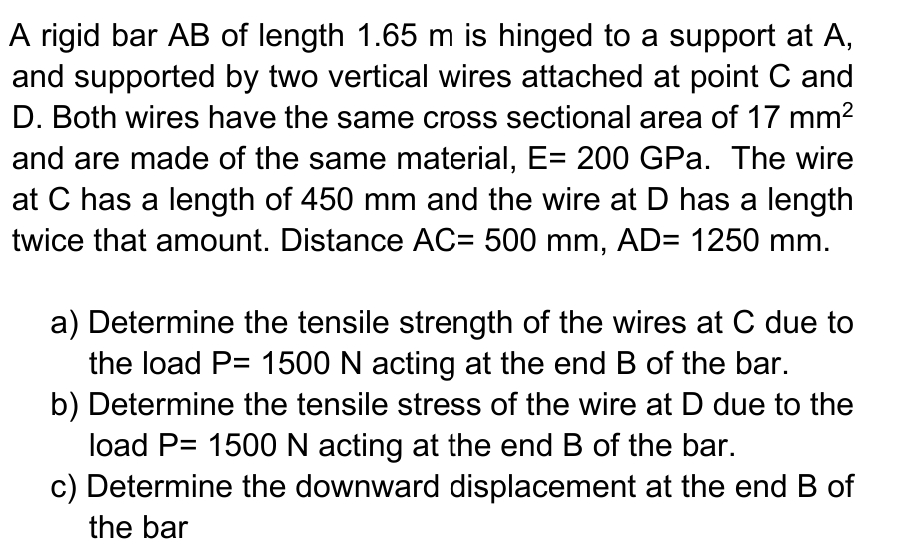A rigid bar AB of length 1.65 m is hinged to a support at A, and supported by two vertical wires attached at point C and D. Both wires have the same cross sectional area of 17 mm² and are made of the same material, E= 200 GPa. The wire at C has a length of 450 mm and the wire at D has a length twice that amount. Distance AC= 500 mm, AD= 1250 mm. a) Determine the tensile strength of the wires at C due to the load P= 1500 N acting at the end B of the bar. b) Determine the tensile stress of the wire at D due to the load P= 1500 N acting at the end B of the bar. c) Determine the downward displacement at the end B of the bar
A rigid bar AB of length 1.65 m is hinged to a support at A, and supported by two vertical wires attached at point C and D. Both wires have the same cross sectional area of 17 mm² and are made of the same material, E= 200 GPa. The wire at C has a length of 450 mm and the wire at D has a length twice that amount. Distance AC= 500 mm, AD= 1250 mm. a) Determine the tensile strength of the wires at C due to the load P= 1500 N acting at the end B of the bar. b) Determine the tensile stress of the wire at D due to the load P= 1500 N acting at the end B of the bar. c) Determine the downward displacement at the end B of the bar
Elements Of Electromagnetics
7th Edition
ISBN:9780190698614
Author:Sadiku, Matthew N. O.
Publisher:Sadiku, Matthew N. O.
ChapterMA: Math Assessment
Section: Chapter Questions
Problem 1.1MA
Related questions
Question

Transcribed Image Text:A rigid bar AB of length 1.65 m is hinged to a support at A,
and supported by two vertical wires attached at point C and
D. Both wires have the same cross sectional area of 17 mm²
and are made of the same material, E= 200 GPa. The wire
at C has a length of 450 mm and the wire at D has a length
twice that amount. Distance AC= 500 mm, AD= 1250 mm.
a) Determine the tensile strength of the wires at C due to
the load P= 1500 N acting at the end B of the bar.
b) Determine the tensile stress of the wire at D due to the
load P= 1500 N acting at the end B of the bar.
c) Determine the downward displacement at the end B of
the bar
Expert Solution
This question has been solved!
Explore an expertly crafted, step-by-step solution for a thorough understanding of key concepts.
This is a popular solution!
Trending now
This is a popular solution!
Step by step
Solved in 2 steps with 2 images

Knowledge Booster
Learn more about
Need a deep-dive on the concept behind this application? Look no further. Learn more about this topic, mechanical-engineering and related others by exploring similar questions and additional content below.Recommended textbooks for you

Elements Of Electromagnetics
Mechanical Engineering
ISBN:
9780190698614
Author:
Sadiku, Matthew N. O.
Publisher:
Oxford University Press

Mechanics of Materials (10th Edition)
Mechanical Engineering
ISBN:
9780134319650
Author:
Russell C. Hibbeler
Publisher:
PEARSON

Thermodynamics: An Engineering Approach
Mechanical Engineering
ISBN:
9781259822674
Author:
Yunus A. Cengel Dr., Michael A. Boles
Publisher:
McGraw-Hill Education

Elements Of Electromagnetics
Mechanical Engineering
ISBN:
9780190698614
Author:
Sadiku, Matthew N. O.
Publisher:
Oxford University Press

Mechanics of Materials (10th Edition)
Mechanical Engineering
ISBN:
9780134319650
Author:
Russell C. Hibbeler
Publisher:
PEARSON

Thermodynamics: An Engineering Approach
Mechanical Engineering
ISBN:
9781259822674
Author:
Yunus A. Cengel Dr., Michael A. Boles
Publisher:
McGraw-Hill Education

Control Systems Engineering
Mechanical Engineering
ISBN:
9781118170519
Author:
Norman S. Nise
Publisher:
WILEY

Mechanics of Materials (MindTap Course List)
Mechanical Engineering
ISBN:
9781337093347
Author:
Barry J. Goodno, James M. Gere
Publisher:
Cengage Learning

Engineering Mechanics: Statics
Mechanical Engineering
ISBN:
9781118807330
Author:
James L. Meriam, L. G. Kraige, J. N. Bolton
Publisher:
WILEY